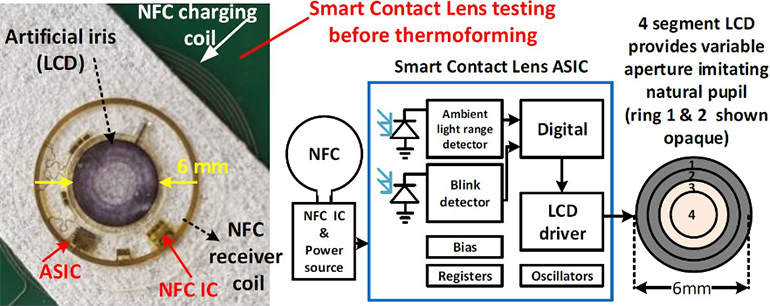The pupil of the eye allows light to reach the retina, and a number of vision disorders are related to irregularities in the iris that surrounds the pupil. People with aniridia, for example, have some or all of the iris missing, exhibiting a large pupil that results in unfocused vision.
Now, a collaboration between Imec, a Belgian research institution, Ghent University, Spain’s Instituto de Investigación Sanitaria Fundación Jiménez Díaz, and Holst Center in The Netherlands, has led to the development of an artificial iris integrated inside a contact lens that can automatically set the proper pupil size to achieve optimal focus and depth of field.
The artificial iris sports a liquid crystal display (LCD) that’s composed of concentric circles that can be made transparent or opaque, depending on the desired pupil size. It’s a very low power prototype, allowing it to work for an entire day on a tiny battery.
“By combining our expertise on miniaturized flexible electronics, low-power ASIC design and hybrid integration, we have demonstrated the capacity to develop a solution for people who suffer from iris deficiencies, higher order aberrations and photophobia, a common yet debilitating symptom seen in many neuro-ophthalmic disorders,” said Andrés Vásquez Quintero from imec/UGent, in an announcement. “Our smart contact lens can control the level of incoming light mimicking a human iris and offering a potential solution to vision correction – by expanding depth-of-field with automatic control of pupil size. This way, our approach can surpass current solutions to combat human eye iris deficiencies. Its beneficial optical effects will be further clinically validated and developed into a medical device.”
A spin-off company has already been formed, called Azalea Vision, to validate and translate the technology into a real medical device.














